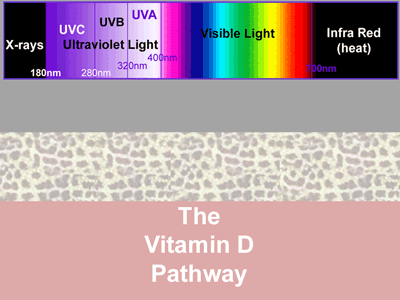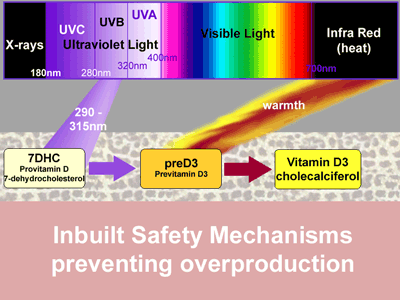|
UV GUIDE
UK
Advances
in Reptile Lighting
A
resource for all reptile keepers
|
|
Sunlight
and Vitamin D
|
| Vitamin
D and Ultraviolet Light - a remarkable process
The
way in which many vertebrates utilise sunlight in the production
of vitamin D3 in the skin, and how this process is also
regulated by the light itself, is still the subject of much
research. Most of the studies relate to human biology, but
researchers such as Holick, Ferguson and Gehrmann in the
United States are gathering evidence that the process is
very similar in reptile skin.9,14,15,16,24
A simplified animated diagram (Figure 1, below) illustrates
the vitamin D pathway.

The
pathway begins when a cholesterol, provitamin
D, (full name 7-dehydrocholesterol, or 7DHC) is manufactured
by cells in the skin. When exposed to UVB at wavelengths
between 290 - 315nm, this provitamin D, held within the
cell membrane, is converted very rapidly indeed to previtamin
D3. The peak production is at 297nm.34
Previtamin D3 is then isomerised (transformed by a re-arrangement
of atoms in the molecule) slowly, in warm skin, over several
hours, to vitamin D3. Warmth
is needed for the reaction to proceed at a normal rate.
Reptiles obtain this heat from the sun, as they bask.
The
vitamin D3 is released from the skin cell membranes and
is taken up by a "vitamin D-binding
protein" into the plasma. It is thus carried in the
bloodstream from the skin to the liver, where it is hydroxylated
to calcediol, 25-hydroxy-vitamin
D3. This is the substance which is tested for in blood samples
taken to assess the reptile's vitamin D status.1,20,27
Calcediol
is then circulated in the bloodstream all around the body.
In the kidneys, some is converted to the active hormone
calcetriol. This plays a major
part in calcium metabolism, governing the levels of calcium
in the blood by controlling absorption of calcium from the
gut and also from the bones, should dietary levels be inadequate
for the body's needs.23
Calcediol
has also, in recent years, been found to play a vital part
in the normal functioning of other organs. It is taken up
by cells throughout the body, and converted intracellularly
to calcetriol. This local action has beneficial effects
upon the immune system, the cardiovascular system, and in
preventing cells in many organs from becoming cancerous
by controlling cell division.22,23
There
is also new evidence that skin cells in sunlight can actually
complete the entire pathway from provitamin D to calcetriol
intracellularly, which may increase the skin's resistance
to cancer.29,30
Calcediol,
in humans, has a half-life of about two weeks in the bloodstream.
In some reptiles, this circulating calcediol may act as
the body's main store of vitamin D. 3
Vitamin D3 does not remain in high concentrations in the
bloodstream. In humans, that which is not hydroxylated to
calcediol in the liver is taken up into body fat, where
it is apparently stored 23
but we are not aware of any studies
ascertaining whether such storage takes place in reptiles,
or if it does, how long such a store might last.
|
| The Regulation of Vitamin D3 Production.
Vitamin
D3 is a substance that is toxic in large amounts. From the
1920s, vitamin D was added to milk for human consumption
to eradicate rickets; however, this was banned in Europe
in the 1950s because children were suffering from overdosage.22
In reptiles, too much vitamin D added to the diet leads to
hypervitaminosis-D, which causes kidney damage, calcification of the soft tissues, including the major blood vessels, and premature
death.42
However, hypervitaminosis-D is not known to occur in basking reptiles (or any other species) obtaining their vitamin D from sunlight, regardless of how long they
bask.23
This is because there are inbuilt
safety mechanisms
preventing overproduction of vitamin D in the
skin. Interestingly, these
also rely upon ultraviolet light, as can be seen in the
animated diagram, Figure 2 (below).

As we
saw earlier, when a reptile basks in full sunlight, previtamin
D3 is produced very rapidly and accumulates in the
skin. Its conversion to vitamin D3
is a much slower, heat dependent process. One might expect
huge quantities of preD3 to build up, but this does not
happen. This is because preD3 is also sensitive to ultraviolet
light up to 325nm; a proportion is converted quite rapidly
into two biologically inactive products, lumisterol3
and tachysterol3. These also
accumulate in the skin.34
Most
of the studies have been conducted on human skin, but the
same process is believed to occur in reptiles; lumisterol3
has been isolated from gecko skin samples exposed to sunlight.16
There
is also a second line of defence against overproduction
of D3. As we saw earlier, vitamin
D3, once produced, is carried away in the bloodstream
to the liver. However, should excess vitamin D3 build up
in the skin - if, for example, more is produced than the
binding protein can remove - ultraviolet light breaks this
down, as well, into three new substances: two
suprasterols and 5,6 trans-vitamin D. This latter
product does have some biological activity; the others are
believed to be inert.43
What happens to all these inert by-products? Research is
ongoing; however, we can speculate that the lumisterol3
and tachysterol3, in particular, might be used as a source
of preD3. This is because their production from preD3 is
a reversible reaction.
Under
ultraviolet light, an equilibrium forms with varying concentrations
of the three, depending in part upon the exact wavelengths
of the light. The three substances have slightly different
action spectra. Lumisterol3 may be converted back to preD3
by light of wavelengths up to 315nm; tachysterol3 responds
right up to 335nm, which is in the UVA range.34
This
might not seem to be a significant difference until one
considers the effect of the atmosphere upon solar radiation.
The lower wavelengths are absorbed more readily by the atmosphere.
When the sun is low in the sky, in the early morning, late
afternoon, and for much of the winter in Northern latitudes,
wavelengths below 300nm may never reach the surface of the
earth at all. At these times preD3 synthesis from provitamin
D almost completely ceases,44,21
but it is at least theoretically possible that the ultraviolet
light of the slightly higher wavelengths could promote the
conversion of tachysterol3, which is incidentally the most
reactive of the three substances, to preD3. If this does
occur, it might provide a source of preD3 when there is
not enough low-wavelength UVB to create sufficient from
provitamin D.
|
| Behavioural
Regulation of UVB Exposure.
Some reptiles may be able to sense whether or not they
need vitamin D, and alter the time they spend basking under
UVB light accordingly. In one study, panther chameleons
(Furcifer pardalis) fed a diet low in vitamin D3
spent more time basking under ultraviolet light than those
on a high D3 diet. In addition, they were more attracted
to lamps emitting UVB than to equally bright lamps which
emitted UVA. Whether they can actually see the UVB is not
known, but they do appear to be able to detect it by some
means.15
Studies like these show how well reptiles are adapted to
make the most of ultraviolet light in their environment.
There's more on the current research into the UV requirements
of lizards in our section:
What UV light do reptiles
need?
Our own studies and recordings are featured in the sections:
Using the UVB meter and
UV light in nature, plus our special investigation into
reptile skin and UVB: The Transmission
of Ultraviolet Light through Reptile Skin Shed.
All these sections are also accessible from the side navigation
bar.
|
|
© 2005 UVGuide.co.uk
|



















